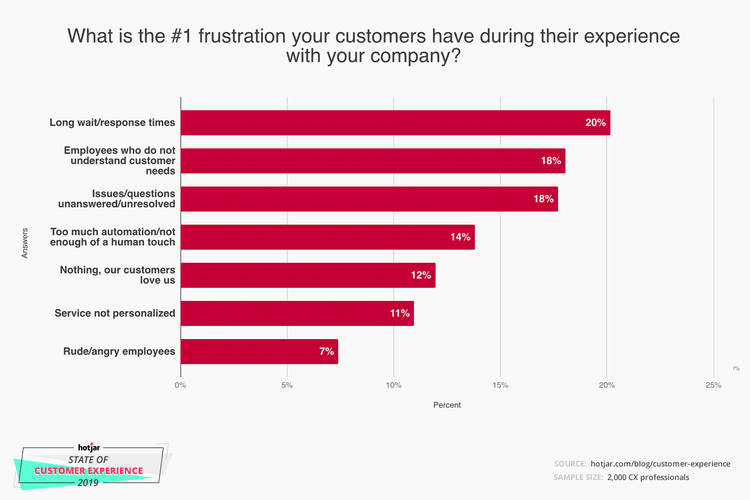What Is Customer Experience? Measuring & Understanding CX

The need for a positive overall customer experience (CX) is rising as a product of an increasingly competitive online market.
In fact, creating a positive overall experience for the customer is now just as key to generating future revenue.
With CX leaders outperforming CX stragglers by as much as 80%, and with a whopping two thirds of brands competing on CX alone, improving your business’s CX culture is of crucial importance.
In this guide, learn more about why customer experience matters and discover tools to understand and improve your CX.
- What Is Customer Experience (CX)?
- Why Customer Experience Matters
- How to Improve Your CX
- Creating a Great CX
- CX Strategy: CX Metrics and How to Interpret Them
- Customer Experience Management Tools
What Is Customer Experience (CX)?

Customer experience is how customers perceive your brand as a whole based on the entirety of their interaction with your business. Understanding and developing a strategy to improve CX is key to customer retention and brand promotion for any business.
Customer Experience vs. Customer Service
The value of customer service as a method to keep customers satisfied is well known – by understanding customer feedback businesses are able to prevent churn and spread the word about their product through satisfied consumers.
But effective customer service is just one process under the greater umbrella of ‘customer experience’.
Let’s get into why your business’s CX matters.
Why Customer Experience Matters
According to a recent Zendesk study, approximately 75% of customers are willing to spend more with companies that deliver a good customer experience.
Why? Well, customers are shopping online more than ever before and have become more discerning while doing so.
Consequently surveys indicate that customer experience is the number one brand differentiator, outpacing product quality and all other factors.
For your business this means that a positive customer experience can separate you from the crowd and a negative one can sink an otherwise great product.
Satisfied customers are likely to become loyal customers who spread the word about your brand. Dissatisfied customers are likely to do the opposite.
In this way, positive customer experience leads to increased customer loyalty which in turn boosts customer retention. According to a recent Forbes article, customers who had a satisfactory experience spent 140% more and, on average, stayed with a company for five years longer.
Customer satisfaction surveys, such as CSAT and NPS surveys are useful tools that allow businesses to gauge customer loyalty.
Both metrics measure satisfaction differently.
Your NPS score measures your customers perception of your business following a major interaction (say a sale or customer service interaction), and is usually calculated quarterly, whereas your CSAT score measures your customers’ satisfaction at each touchpoint along their journeys.
Calculating these and other customer satisfaction metrics allow you to have a more accurate and holistic picture of your business’s customer experience.
In short, creating a positive customer experience can increase revenue by:
- Increasing customer retention
- Spreading good word-of-mouth via loyal customers
- Using customer feedback to better understand your customers’ voices
So what might be holding you back from providing your best possible customer experience?
How to Improve Your CX
Supplying a good customer experience is easier said than done. While 80% of businesses believe that they provide a superior customer experience, only 8% of customers believe they received a great customer experience according to Bain & Co.
This is called the ‘customer experience gap’ and it emphasizes why properly measuring and understanding your CX is vital to improving it.
Accurately Measure CX
Customer experience is best quantified on a macro (overall) and micro (function specific) level respectively by calculating your CSAT and NPS scores.
Once you have your score, before jumping to conclusions, it is important to take into account a couple factors that may be impacting it, the most significant being Customer Tolerance and Timing.
The industry you're in weighs heavily on how customers rate their experience of your product or service. Customer Tolerance measures how much customers depend on your service by asking them how likely they are, on a scale of 1-10, to be upset if your service doesn’t meet their needs.
Services ranked closer to 10, meaning the customer is very likely to be upset, are part of ‘low-tolerance’ industries, such as healthcare and airlines. On the other end of the spectrum, services ranked closer to 1 occupy ‘high-tolerance’ industries, such as ecommerce. This can help put your CX metric scores in perspective.
Additionally, your Timing, meaning how and when in the process you reach out for customer feedback, can also skew your scores – you don’t want to annoy customers with constant prodding for feedback, nor do you want to reach out too late by which time the customer may have forgotten how they felt.
Keeping this in mind, we can jump into the biggest factors that may be dragging your CX down.
Avoid Customer Experience Detractors
Because each business provides a slightly different service and occupies a unique position amongst its competition, CX approaches need to be customized for every individual business. But, a few specific factors tend to detract from good customer experience across the board.
According to a recent Hotjar survey depicted below the top six causes of bad customer experience are:
- Long wait times
- Employees who do not understand customer needs
- Unresolved issues/questions
- Too much automation/not enough of a human touch
- Service that is not personalized
- Rude/angry employees

Notice how these categories directly relate to customer service interactions (long wait/response times, employees who do not understand customer needs, issues/questions unanswered/unresolved, and too much automation.)
Customer support interactions have the most impact when it comes to customers’ perceptions of a business.
Whether it is with an automated help service or a live support agent, 43% of customers say that their brand loyalty was significantly impacted by their interactions with customer service.
Effectively listening to your customers’ voices and accurately interpreting what they are saying following customer service interactions is the surest way to an improved experience.
But why stop at ‘improved’ - why not try for great CX?
Creating a Great CX

As a customer feedback conscious business your next step might be to figure out exactly what you should listen for. We’ve distilled four essential steps to improving your overall CX:
- Limit customer pain points (personalized, user-friendly platform)
- Refine your feedback loop (Ask the right question at the right time)
- Make listening to voice of customer (VoC) a company priority
- Effectively analyze customer feedback
Let’s get into each of these.
1. Limit customer pain points
Limiting customer pain points reduces friction with your product and allows for less customer churn in the long run. While each business and product has its own distinctive flaws and as such require different tweaks, here are some areas for improvement any business should be aware of.
User onboarding is an absolutely critical step in the customer journey because of its outsized impact on overall perception. You’ve heard the expressions ‘first impressions matter’ – this rings just as true in CX.
Onboarding, meaning the process of teaching new customers to use your product or service, when done correctly can be an enormous boon for any business, doubly so for SaaS businesses. Not everyone is tech-savvy and a large user base could end up alienated without a proper tutorial.
Customer service experience, as previously mentioned, tends to rank incredibly highly as a point of customer friction.
Effective customer service response analysis can help inform your business of what stages of your customer service experience require the most attention and what, specifically, customers are having issues with at these stages.
The need for increased personalization has emerged as a prominent desire among customers. Both in the product experience itself and during support scenarios, customers want to feel that their specific needs are being heard and addressed.
2. Refine your feedback loop
Your customers want to be asked for their feedback at the right time, and in the right manner. This means refining where and when you send surveys i.e. making sure you’re not bombarding the customer with requests for feedback, or, on the other side of the scale, waiting so long to ask for feedback that customers’ have forgotten how they felt about their experience.
And don't forget to close the loop, in other words follow up with the customer to let them know that you've listened to their feedback and implemented solutions to improve their experience.
3. Make listening to VoC a top priority
Efficiently soliciting and interpreting customer feedback is a must – but what is the best way to go about this?
The promotion of an improved company-wide ‘listening culture’ that emphasizes listening to multiple kinds of feedback done across a variety of platforms is your best bet.
Here’s a list of key feedback and listening approaches to help build an improved listening culture:
- Journey feedback, closely linked to NPS surveys, measures your customers overall opinion about a brand, product or service.
- Interaction feedback, similar to a CSAT survey, measures a customer’s perception at a specific touchpoint, for example following an attempt to get an answer through a support chatbot. By measuring this you get a look into customers’ responses to a specific function, allowing you to discern what is working and what isn’t.
- Social listening, or passive listening, pertains to collecting customer sentiment from the internet at large – this means online reviews, Twitter, Facebook, etc.
- Real-time listening is the ability to listen and respond to customers on the go, wherever they may be leaving messages. For example, via built-in options such as a chatbot or on social media.
The 2021 Driving Consumer Loyalty Report found that, when surveyed, 40% of consumers believed brands committed to meeting CX expectations should provide a live agent online chat service.
4. Effectively Analyze Customer Feedback
Having applied all of these listening methods you are going to have a heap of data at your feet. With responses of both the numeric (1-10) variety as well as open-ended (text based) responses, the methods you employ to analyze this data will be just as important as its collection.
Here Monkeylearn’s machine learning services can be useful. With various AI survey analysis techniques, you can effectively analyze and quantify the contents of text-based customer responses in real-time and at scale.
See what a practical application of this would look like by trying our survey feedback classifier, which can parse what the topic of a given customer response is, or our sentiment analyzer which can extract the intended emotion from text data to help you group and quantify what your customers are saying.
For further instruction and a breakdown of elements that an effective CX strategy should include, read on.
CX Strategy: CX Metrics and How to Interpret Them

Here we are going to get into the nitty-gritty of what metrics to consider and how to best implement a comprehensive CX strategy. We are going to break down the hierarchy of CX related terms and explain all of the most important CX metrics.
Get ready for some acronyms!
We are going to approach CX strategy via these three steps:
- Managing CX: CRM vs CXM
- Measuring CX: CX Metrics and What They Mean
- Modulating CX: 6 Final Touchpoints
Managing CX: CRM vs CXM
First, let’s go over what we mean by Customer Relationship Management (CRM) and Customer Experience Management (CXM).
Customer Relationship Management (CRM) is the larger umbrella term – both CX itself and Customer Experience Management (CXM) are parts of the larger CRM whole. While less useful for our customer experience improving needs, CRM is used to inform marketing and sales teams on their strategy based on past data.
Customer Experience Management (CXM), on the other hand, seeks to capture and understand what customers think about their interaction with your company at any given touchpoint, regardless of whether there was a sale or not. The name of the game for good CXM is to improve perception whereas good CRM seeks to improve sales.
By understanding the difference between these two we can better conceptualize our CX strategy goals – improving perception should be the number one priority in a modern CX approach as it promotes loyalty – increased sales, in turn, will naturally result from a great customer experience.
Measuring CX: CX Metrics and What They Mean
To gain a more accurate picture of where your business stands, we are adding two more metrics to our catalogue.
The four primary CX metrics are:
- Net Promoter Score (NPS)
- Customer Satisfaction Score (CSAT)
- Customer Effort Score (CES)
- Time To Resolution (TTR)
We’ve previously touched on the NPS score, which measures overall perception of your business on a scale of 1-10, and the CSAT score, which gauges customer satisfaction at various touchpoints in their customer journey. These are both measures of customer satisfaction.
Customer Effort Score (CES), however, seeks to measure the perceived difficulty of a given interaction for your customers. Customers are asked how difficult or easy they felt an interaction was as compared to how difficult they thought it would be.
Because it measures difficulty, your CES score provides a helpful gauge of customer perception – it allows them to inform you of whether they thought the process was easier or harder than it could have been.
Time To Resolution (TTR), unlike all three of our other metrics, does not require a customer response. Rather, it is the average time required to resolve a ticket/ customer service issue after it has been opened.
With long wait times topping the list of customer service related complaints, and unanswered/unresolved issues coming close behind, lowering your TTR can be crucial to lowering customer frustration.
While making use of these new metrics, here are some final CX areas to examine.
Modulating CX: 6 Final Touchpoints
Beyond those we outlined in Creating a Great Customer Experience here are five new action items to further hone your CX strategy:
- Deliver Personalization
- Segment Customers
- Consider Customer-Facing Employee Feedback
- Analyze Support Ticket Trends
- Implement Proactive AI
Delivering personalization is essential in an online market abounding with alternatives – customers are more likely than ever to switch to another company with 41% of U.S. consumers saying they have switched brands due to a lack of personalization.
Luckily, hyper-personalized customer service is possible through collaboration between your live support team and intelligent automation.
AI tools can empower your customer support staff by indexing and referencing large amounts of data in order to make finding solutions easier, detect behavior patterns, and create detailed customer profiles.
Ideally, this allows for your customers to not only get help faster, but receive more personalized help when a live agent is available. This goes hand in hand with the need to:
Properly segment customers in order to determine which groups to target with increased attention.
Understanding your diverse base of customers is key to improving their future interactions. If, for instance, you find that customers who interact with your support team tend to stay loyal to your brand longer, then you know you are delivering a good support experience!
Customer segments can also be generally analyzed for churn and/or expansion data – discovering which groups of customers are shrinking allows you to pay them greater attention in order to decrease churn.
Considering front-facing employee feedback can be key to improving efficiency and overall perception of your customer service. After all, who knows more about what problems customers are having than your employees?
By implementing more frequent check-ins with employees you can gain a more accurate picture of common customer pain points while also learning what difficulties your employees are facing. Dealing with these difficulties should make it easier for employees to help customers and consequently lead to a better overall CX – happy employees means happy customers.
Further mining your customer support experience for useful customer insightshould involve analyzing support ticket trends. Knowing how to properly ask and interpret responses to open ended questions is the crux of this process.
All of these techniques share two commonalities:
- Their end goal is to measure and improve overall customer satisfaction
- They can be made most effective by taking advantage of proactive AI.
In the past, AI has gotten a reputation for being cold and calculating, but this is no longer the case. No-code AI tools, such as Monkeylearn’s sentiment analyzer, are accessible to everyone.
Learn more about sentiment analysis and how you can use it to improve CX.
Let’s take a tour of what advanced CX management tools are currently available.
Customer Experience Management Tools

MonkeyLearn
With a focus on smart, customer friendly AI, Monkeylearn supplies a suite of AI tools that can be customized for any business model. Monkeylearn Studio analyzes all of your customer feedback and visualizes the results in real-time so you can discover exactly what your customer experience is lacking or not.
Try out tools such as our email classifier, or schedule a free demo of our complete suite.
Hotjar
If you are looking to analyze how your customers use your website, Hotjar has you covered. Hotjar’s heatmap and behavior analysis service allows you to calculate your NPS and CSAT scores in real-time based on how your customers are interacting with your site. Furthermore, their service gathers web behavior data so that you can see where exactly on your site users are running into dead ends.
SuperOffice
Remember Customer Relationship Management, or CRM? That’s SuperOffice’s specialty – they offer a cloud based platform that aims to personalize customer journeys at scale by gathering data from customer interaction at as many touchpoints as possible.
WalkMe
Another option for managing customer journeys is WalkMe. WalkMe provides a future-oriented, customer-success driven platform that seeks to streamline your customer experience strategy.
Satmetrix
Satmerix’s agile software suite approaches Customer Experience Management (CXM) with an emphasis on real-time customer insight and increasing employee engagement by providing data-driven customer analysis for employees at all levels.
Khoros
Khoros is a popular customer-interaction focused gathering software that allows you to gather all customer interaction with your business, be it from SMS, support logs, or social media, and view it all in one place. They also offer personalized user onboarding support so you can effectively coach your employees about onboarding best practices.
Takeaways
That’s a lot of CX talk – but understanding how the modern approach to customer experience has changed is crucial for businesses that want to create a customer-centric experience.
The best customer experience strategies understand that the primary goal of any effective CX approach should be to increase positive perception of your brand. With positive perception comes brand loyalty – a commodity more valuable than the success of any individual sale.
In the cutthroat, modern online market customer loyalty generated from a positive experience is the most valuable aspect of a business-customer relationship. If a customer has a good time interacting with your brand they are much more likely to return and spread the word about your product or service rather than switching to a competitor.
Want to learn more about how AI is transforming the customer experience?
Sign up for free to try Monkeylearn’s customizable AI tools or request a demo to see the detailed insights you can gain from an in-depth customer experience analysis.


